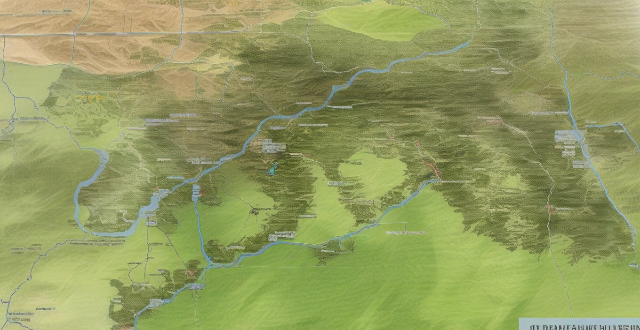Cultural Adaptation

What are the ethical considerations in climate adaptation planning ?
This article discusses ethical considerations in climate adaptation planning, including fairness and justice, environmental sustainability, transparency and accountability, intergenerational equity, and cultural sensitivity. It emphasizes the importance of equitable distribution of resources, minimizing negative environmental impacts, involving stakeholders in decision-making processes, considering the needs of future generations, and respecting cultural diversity in adaptation efforts.

What is climate adaptation and why is it important ?
Climate adaptation is a proactive approach aimed at minimizing harm and exploiting the benefits of global changes by adjusting to expected impacts, such as protecting ecosystems and human health, avoiding costly damages, and preserving cultural practices. It involves structural adjustments like infrastructure reinforcement and water management, policy integration, public education, technological advancements in early warning systems, and the promotion of green infrastructure. Adaptation strategies are crucial for building community resilience, ensuring economic sustainability, and fostering long-term development.

What is cultural fusion and why is it important ?
The text discusses cultural fusion, which is the blending of different cultural elements from various backgrounds. This process involves exchange, adaptation, and integration of traditions, customs, languages, cuisines, arts, etc. Cultural fusion is important because it promotes diversity and inclusivity, drives innovation and creativity, facilitates global understanding and peace, enhances economic opportunities, and supports sustainable development. It is essential for promoting harmony, innovation, and sustainability in an increasingly interconnected world.

What challenges do people face when participating in cultural exchanges ?
Cultural exchanges, while enriching, present challenges like language barriers, cultural differences, adjustment difficulties, stereotyping, legal and practical issues, and emotional strain. To overcome these, participants should be open-minded, patient, and willing to learn, with preparation through training, classes, and mentorship.

What is the relationship between social inequality and access to resources for climate adaptation ?
The relationship between social inequality and access to resources for climate adaptation is influenced by economic, social, and political factors. Wealthier individuals often have more resources, while marginalized groups may face discrimination. Education plays a crucial role in raising awareness about climate change, and cultural beliefs can impact adaptation strategies. Government policies can either exacerbate or mitigate social inequality, and participatory decision-making processes are essential for equitable resource allocation. Addressing social inequality requires equitable resource allocation, capacity building, community-driven approaches, and targeted interventions for vulnerable populations.

How has globalization impacted cultural diversity around the world ?
Globalization has significantly impacted cultural diversity, leadingGlobalization has significantly impacted cultural diversity, leading adaptation but also potential homogen Policy and governance play a role in cultural preservation, with local resistance movements countering globalization effects. Striking a balance between global benefits and cultural preservation is crucial for maintaining diversity.

What challenges do businesses face when dealing with cultural diversity ?
Businesses operating globally face challenges with cultural diversity impacting communication, decision-making, and productivity. Key challenges include: 1. **Communication Barriers** due to language differences, non-verbal cues, translation issues, and accents/dialects. 2. **Cultural Stereotyping** leading to generalizations, lack of awareness, and assumptions based on cultural backgrounds. 3. **Values and Beliefs Conflicts** arising from work ethic variations, religious practices, and differing attitudes toward gender roles. 4. **Legal and Ethical Considerations** such as navigating employment laws, ethical standards, and data privacy regulations. 5. **Organizational Practices** including management styles, decision-making processes, and feedback mechanisms that vary across cultures. 6. **Adaptation and Change Management** challenges like resistance to change, training needs, and continuous learning requirements. Addressing these challenges requires proactive strategies to ensure all employees feel valued, respected, and can contribute to the organization's success.

What are some innovative examples of climate adaptation in developing countries ?
Climate adaptation is becoming increasingly important for developing countries, which often lack the resources to cope with the impacts of climate change. However, these countries are also finding innovative ways to adapt to changing environmental conditions. Here are some examples: 1. Integrated Watershed Management 2. Climate-Smart Agriculture 3. Ecosystem-Based Adaptation 4. Urban Green Infrastructure 5. Community-Based Adaptation

What are some examples of successful adaptation strategies for climate-induced migration ?
Successful adaptation strategies for climate-induced migration include resilient infrastructure development, economic diversification, community-based adaptation, and environmental conservation and restoration. These approaches aim to increase community resilience, reduce reliance on climate-sensitive sectors, empower local decision-making, and protect ecosystems.

What role do urban green spaces play in climate adaptation strategies ?
Urban green spaces play a crucial role in climate adaptation strategies by providing cooling effects, carbon sequestration, flood control, and habitat preservation. To effectively incorporate these spaces into climate adaptation efforts, city planners should conduct assessments, develop comprehensive plans, collaborate with local communities, monitor and evaluate projects, and educate residents about the benefits of green spaces.

How does climate adaptation relate to sustainable development goals ?
Climate adaptation is a vital component of sustainable development goals (SDGs) as it helps reduce vulnerabilities and build resilience to the adverse effects of climate change, thereby contributing to the achievement of several SDGs. Relevant SDGs include Goal 1: No Poverty, Goal 2: Zero Hunger, Goal 3: Good Health and Well-being, Goal 6: Clean Water and Sanitation, Goal 11: Sustainable Cities and Communities, Goal 13: Climate Action, and Goal 15: Life on Land. Strategies for integration include policy coherence, financial investment, capacity building, stakeholder participation, risk assessment, research and innovation, and education and awareness. By addressing the challenges posed by climate change through effective adaptation strategies, nations can work towards creating more resilient societies that are better prepared to face future climate risks while continuing to progress towards other SDGs.

What are the most effective strategies for community climate adaptation ?
Effective strategies for community climate adaptation include risk assessment and planning, infrastructure upgrades, sustainable land use practices, and education and awareness. These strategies aim to reduce vulnerability and enhance resilience to the impacts of climate change.

How do climate adaptation strategies fit into environmental law frameworks ?
Climate adaptation strategies are vital for reducing vulnerability to climate change and fit into environmental law frameworks by providing a legal basis for implementation. These strategies involve measures to help communities and ecosystems adapt to changing climatic conditions. Environmental laws establish principles like the precautionary principle and intergenerational equity, guiding climate adaptation development. Integrating adaptation into existing environmental laws is crucial for effective implementation. Key components of adaptation strategies include vulnerability assessment, plan development, measure implementation, and progress monitoring. Challenges in implementing adaptation through environmental law include insufficient authority, resource constraints, and lack of coordination, but opportunities exist to enhance legal mandates, provide financial incentives, and promote cross-sector collaboration. Overall, climate adaptation strategies are essential within environmental law frameworks to ensure reduced vulnerability and enhanced resilience to climate change impacts.

What are the benefits of embarking on a cultural exploration journey ?
Embarking on a cultural exploration journey is an enriching experience that offers numerous benefits, including expanding your horizons, enhancing communication skills, boosting creativity, developing cultural sensitivity, strengthening adaptability, building global awareness, forging lasting connections, and promoting personal growth and self-discovery.

How do climate adaptation measures vary across different regions ?
Climate adaptation measures are strategies and actions taken to reduce the impacts of climate change on human lives, ecosystems, and economies. These measures vary significantly across different regions due to factors such as geography, climate patterns, socio-economic conditions, and technological capabilities. Coastal and island communities face challenges like sea-level rise, storm surges and hurricanes, and erosion, while arid and semi-arid regions face water scarcity, desertification, and droughts. Mountainous regions face glacier retreat, changes in snowmelt patterns, and landslides and mudflows. Urban areas face challenges like heat island effect, flooding due to impervious surfaces, and air pollution exacerbated by heat waves. Arctic regions face permafrost thaw, changes in wildlife migration patterns, and infrastructure damage due to extreme cold. In conclusion, it is crucial for local governments, international organizations, NGOs, and community members to work together in designing and implementing effective adaptation strategies tailored to their unique circumstances.

How can we measure the effectiveness of community climate adaptation efforts ?
Measuring the effectiveness of community climate adaptation efforts is crucial for understanding their impact on resilience to climate change. Key steps include setting clear objectives, developing relevant indicators, collecting and analyzing data, transparent reporting, evaluating success, iterative improvement, community engagement, and policy alignment. By following these steps, communities can ensure their adaptation efforts are effective and continuously improved.

How do climate adaptation policies integrate water resource management ?
Climate adaptation policies play a crucial role in water resource management by assessing climate change impacts, developing adaptation strategies, implementing and monitoring measures, securing finance and investment, and promoting education and awareness. These efforts aim to reduce vulnerabilities of human and natural systems to climate change, focusing on risks such as temperature changes, precipitation variability, and extreme events. Adaptation strategies include water conservation, infrastructure adaptations, legal and institutional frameworks, pilot projects, monitoring and evaluation, capital investment, operational costs, public education campaigns, and capacity building. This integration ensures water security for future generations by addressing the complex interactions between climate change and water resources.

How can we promote cultural diversity in our community ?
Promoting cultural diversity is crucial for fostering understanding and respect among people from different backgrounds. To achieve this, we can organize cultural events, promote multicultural education, encourage intercultural dialogue, support local businesses owned by diverse individuals, increase diverse representation in media, and promote cultural exchange programs. By embracing these strategies, we can create an inclusive and harmonious society where everyone feels valued and respected.

How can cultural fusion be promoted within multicultural communities ?
Promoting Cultural Fusion in Multicultural Communities emphasizes the importance of understanding and valuing diversity, fostering dialogue and exchange, promoting inclusion and equity, supporting cultural preservation and innovation, implementing policies and practices, and building partnerships and collaborations. These strategies aim to create a community where diverse cultures are celebrated and respected, leading to a richer and more innovative community life.

Can cultural fusion lead to a loss of cultural identity ?
Cultural fusion, the blending of different cultures, has been a phenomenon for centuries. However, with globalization and the rise of social media, cultural fusion has become more prevalent than ever before. While it can lead to the creation of new and exciting cultural expressions, it can also raise concerns about the potential loss of cultural identity. This article explores whether cultural fusion can indeed lead to a loss of cultural identity by examining the benefits of cultural fusion, the potential loss of cultural identity, and ways to maintain cultural identity amidst fusion.

How can policymakers encourage private sector involvement in climate adaptation ?
To encourage private sector involvement in climate adaptation, policyTo encourage private sector involvement in climate adaptation, policy as creating incentives like tax policymakers can implement strategies such as creating incentives like tax breaks and subsidies, establishing clear regulations with compliance enforcement, facilitating information sharing through open data access and collaborative platforms, promoting public-private partnerships with joint projects and long-term commitments, enhancing capacity building via training programs and technical assistance, and recognizing and showcasing success stories through awards and media coverage. These steps will foster a collaborative environment where the private sector actively seeks opportunities to contribute to resilient and sustainable solutions for climate change challenges.

How can small island nations develop successful climate adaptation plans ?
The text provides a comprehensive guide on how small island nations can develop successful climate adaptation plans to protect their communities and ecosystems from the impacts of climate change, which include sea-level rise, storm surges, and extreme weather events. The suggested steps are grouped into several categories: assessing risks and prioritizing actions; building resilience through infrastructure; enhancing ecosystem resilience; community engagement and education; developing policies and legislation; finance and funding mechanisms; and monitoring and evaluation. Each category offers specific strategies and actions that small island nations can take to create effective climate adaptation plans.

How do food festivals promote cultural diversity and understanding ?
Food festivals are significant events that promote cultural diversity and understanding by offering educational opportunities, exposing attendees to new flavors, building community, impacting the economy positively, providing entertainment, enhancing social media presence and awareness, and promoting sustainability initiatives. These festivals facilitate cross-cultural dialogue, break down cultural barriers, and encourage a shared appreciation for global cuisine.

How can we ensure that climate change adaptation measures are equitable and just ?
The topic of ensuring equitable and just climate change adaptation measures is crucial for protecting vulnerable communities, avoiding inequality amplification, and promoting sustainability. Key principles include prioritizing the most vulnerable, transparency and public participation, equitable resource allocation, legislative and policy support, capacity building and education, and international cooperation. Implementing these principles involves assessment and planning, integration with development goals, and monitoring and evaluation. By following these guidelines, we can ensure that adaptation measures are fair and just for all.

What is the connection between climate change mitigation and adaptation goals ?
The text discusses the interconnected nature of climate change mitigation and adaptation goals, highlighting their distinct objectives and shared purpose of addressing global warming. Mitigation focuses on reducing greenhouse gas emissions to limit the magnitude and rate of climate change, while adaptation prepares for the inevitable impacts by enhancing resilience and reducing vulnerability. The two strategies complement each other, with some actions achieving both goals simultaneously. Investing in both leads to long-term benefits, making a comprehensive approach essential for managing climate change challenges.

How do climate adaptation strategies differ between rural and urban areas ?
Climate adaptation strategies differ between rural and urban areas due to infrastructure, resources, community needs, and environmental impacts. Urban areas often have advanced technology and diverse stakeholders involved in adaptation planning, while rural areas rely more on local knowledge and community-based initiatives. Funding and resources are also key factors, with urban areas having better access to funding for large-scale projects and a diversified economy to support climate adaptation measures. In contrast, rural areas may have limited financial resources and dependence on agriculture, making them vulnerable to climate impacts. Community participation is crucial in both settings, but urban areas may have more platforms for participatory planning and decision-making processes, while rural areas benefit from strong community cohesion and collective action. Environmental impact considerations also vary, with urban areas facing challenges like the heat island effect and air pollution, while rural areas focus on natural resource management and watershed protection.

How can we raise awareness about the importance of community climate adaptation ?
To raise awareness about the importance of community climate adaptation, several strategies can be employed: 1. **Education and Outreach Programs**: Conduct workshops, engage schools, collaborate with media outlets, and develop informational materials to educate people about climate change and its implications. 2. **Community Engagement Initiatives**: Encourage public participation in discussions, foster partnerships with local organizations, and promote civic leadership to drive climate adaptation efforts. 3. **Visual Aids and Creative Approaches**: Use art, performances, exhibits, infographics, and other creative means to communicate the importance of climate resilience. 4. **Online Platforms and Social Media**: Leverage digital tools like social media campaigns, online forums, virtual reality experiences, and interactive apps to reach a wider audience. 5. **Policy Advocacy and Support**: Advocate for favorable policies, provide financial incentives, and support legislation that enhances community resilience against climate change.

Which Asian countries should I visit for a cultural experience ?
Asian countries offer a diverse range of cultural experiences, including festivals, traditional practices, and historic landmarks. Recommended destinations include Japan's Kyoto and Tokyo, China's Beijing and Shanghai, India's Delhi and Agra, Thailand's Bangkok and Chiang Mai, Vietnam's Hanoi and Ho Chi Minh City, and South Korea's Seoul and Busan. Each country offers unique cuisine and activities for travelers seeking a rich cultural experience.

Can you recommend luxury resorts that offer unique cultural experiences ?
This article recommends several luxury resorts worldwide that offer unique cultural experiences. The Four Seasons Resort Bali at Sayan, Amangiri, Capella Ubud, The Brando, Como Shambhala Estate, Hacienda de San Antonio, and Mandapa, Ritz-Carlton Reserve are among the featured resorts. Each provides a blend of luxurious accommodations and immersive cultural activities such as dance classes, guided hikes, spiritual journeys, cooking classes, and more. These resorts are located in diverse settings, including jungles, deserts, mountains, and coastal areas, offering opportunities to explore local traditions, cuisine, history, and natural beauty.

Is there a risk that cultural fusion could result in cultural homogenization ?
The text discusses the risk of cultural homogenization that comes with cultural fusion, which is the blending of different cultures. This process leads to the loss of distinctive features of individual cultures as they become increasingly similar due to globalization, migration, and other forms of cultural interaction. The phenomenon of cultural homogenization is characterized by the loss of heritage, dominance of global culture, and erosion of local practices. Several factors contribute to this, including globalization, mass media, migration, and economic influence. To mitigate the risk, it is essential to promote cultural preservation and exchange while discouraging the domination of any single culture. This can be achieved through supporting local cultures, cultural exchange programs, education, and policy measures.